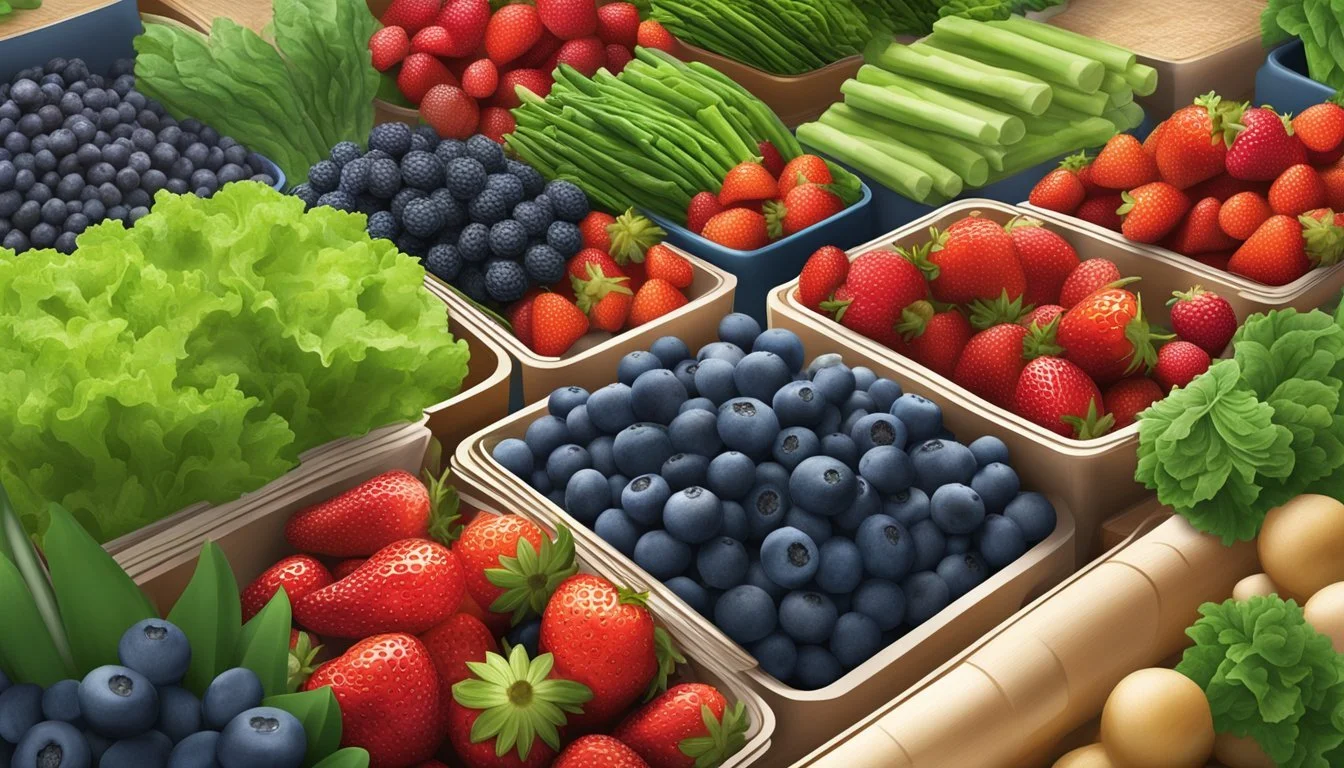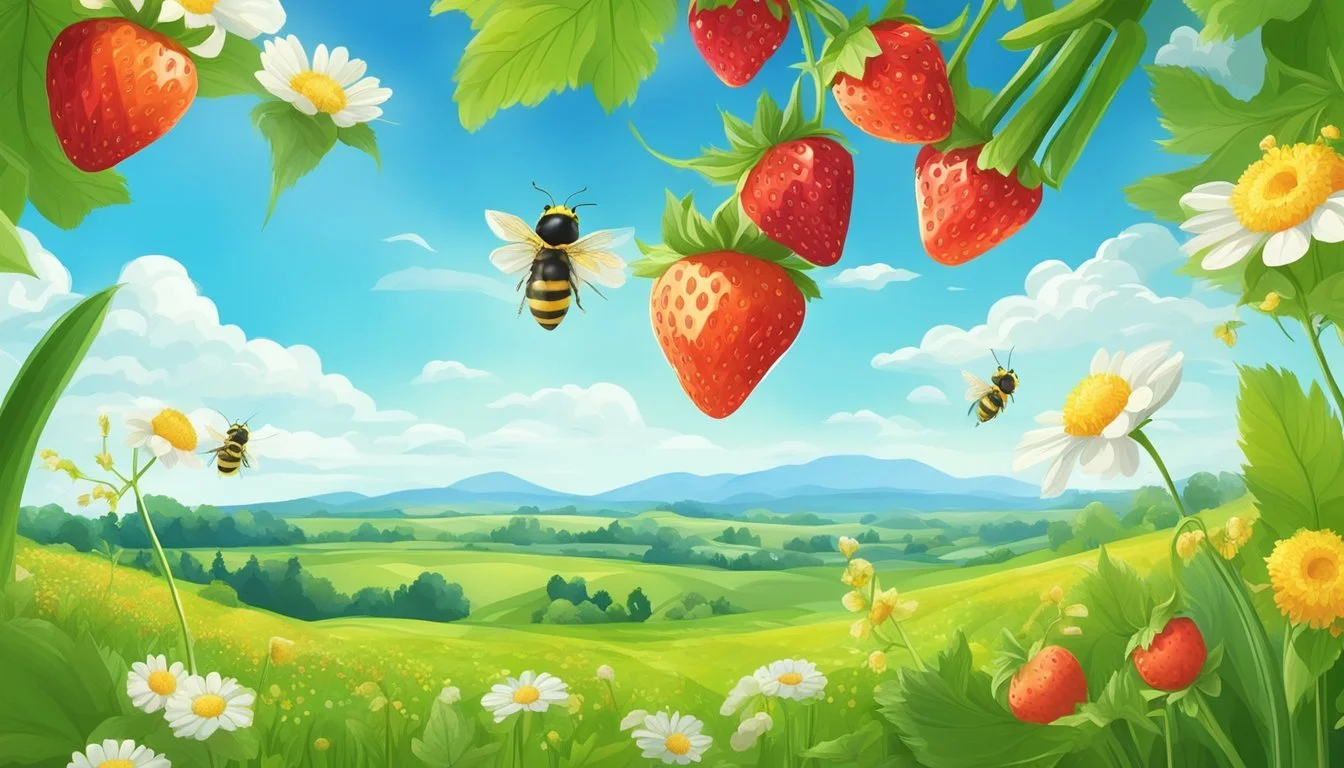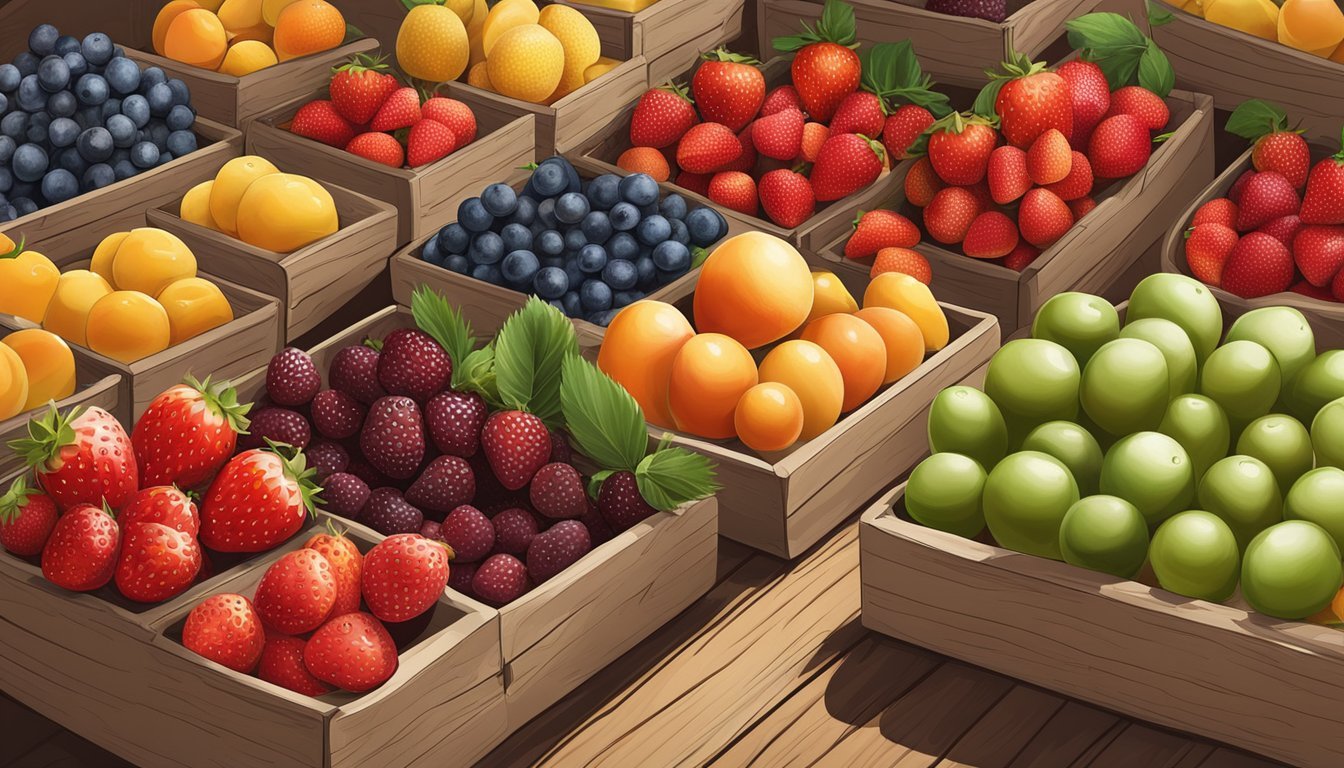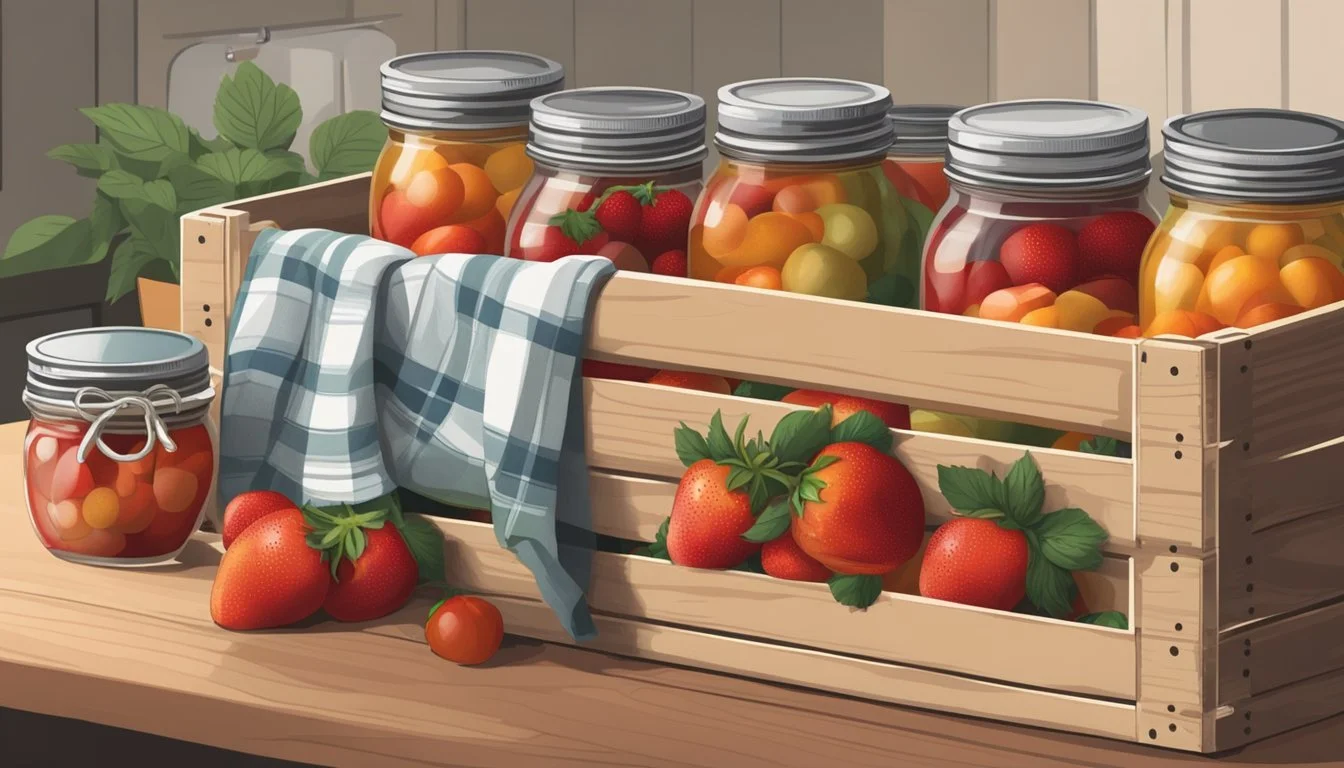Missouri Seasonal Fruit & Vegetables in May
Your Fresh Guide
This Article is Part of our Missouri Seasonal Fruit & Veg Calendar
In Missouri, the arrival of May signals a shift in the agricultural calendar. It's a pivotal time of year when the state transitions from the cool, budding days of spring into the cusp of an abundant summer harvest. This period is characterized by a variety of fresh produce beginning to reach its peak, giving consumers access to some of the best local flavors available.
Missouri's diverse climate and fertile soils contribute to a wide array of fruits (What wine goes well with fruit?) and vegetables that become available in May. Residents and visitors alike can enjoy the burgeoning selection of fresh produce, including the vibrant hues and crisp textures of spring's leafy greens and the first sweet hints of summer fruits. The agricultural landscape of the state comes alive as local farms start to harvest and markets brim with the season's offerings.
During this month, seasonal eating is a testament to the rhythms of nature in the Heartland. Consumers opting for local Missouri produce not only support the region's farming communities but also benefit from the nutritional advantages of eating foods at their peak freshness and flavor. With a commitment to sustainability and community health, the season's bounty is embraced and celebrated throughout the state.
Seasonal Cycles and Selecting Produce
In Missouri, May marks a pivotal transition in local agriculture, showcasing a variety of fresh, in-season produce. Consumers should focus on the state's growing cycles and standards of quality when selecting fruits and vegetables during this month.
Understanding Missouri's Growing Seasons
Missouri enjoys a diverse climate across its geographical expanse, attributable in part to its placement within several hardiness zones ranging from 5b to 7a. In May, the state's growers are typically amidst the late spring cycle, a time when the frost has passed and many plants enter their growth and later harvest phases. During this period, individuals can anticipate the availability of fresh produce like beets (how long do beets last?), broccoli (how long does broccoli last?), cabbage, and other cool-season crops that thrive in Missouri conditions.
Crops typically in season in May include:
Beets
Broccoli
Cabbage
Greens (e.g., kale, spinach)
As June approaches, the selection broadens considerably with the addition of warmer-season crops such as berries. However, fruits like peaches, which come into prominence in July, are not yet at their peak in May.
Choosing Quality Fruit and Vegetables
When assessing the quality of fruit and vegetables, shoppers should consider several indicators. For produce like beets and broccoli that are in season throughout May, look for vibrant coloration and firm textures as these typically denote freshness. Leafy greens should appear crisp and unblemished.
Quality indicators:
Beets: Firm, smooth, and deep in color; smaller ones are typically sweeter.
Broccoli: Dark green crowns, sturdy stems; avoid yellowing florets.
Cabbage: Compact, firm heads that are heavy for their size.
Greens: Lively, unwilted leaves without signs of yellowing or damage.
It is crucial for consumers to take advantage of the harvest periods in Missouri by seeking out the freshest and highest-quality produce available. Knowing the state's seasonality can greatly benefit one's experience with local fruits and vegetables, offering superior taste and nutritional value.
Fruit Availability in May
In May, Missouri offers a promising selection of fresh fruits, including an array of berries and some of the first stone fruits of the year.
Berries and Early Season Fruits
Missouri's May fruit harvest primarily consists of early-season berries. Strawberries are a highlight, making their sweet, vibrant debut. At this time, they are at peak ripeness, offering high quality and flavor. Additionally, blueberries begin to appear towards the end of May, introducing their fresh, plump goodness to the market.
Strawberries: Peak season begins, perfect for picking
Blueberries: Late-May arrivals, starting the season
Stone Fruits Beginnings
May is also the month when stone fruits start to make their first appearances in Missouri, albeit in the later part. Cherries and apricots are among the earliest stone fruits available. However, it's important to note that they are often not at their full abundance until June.
Cherries: Early varieties start to come into season
Apricots: Limited quantities may be available, with increased abundance in the following month
Vegetable Harvest in May
May in Missouri brings a period of thriving growth for a variety of vegetables. Gardeners and farmers see an abundance of produce ready for harvest, especially leafy greens and salad staples, along with a selection of root vegetables and pods.
Leafy Greens and Salad Staples
During May, Missouri's soil nurtures a variety of leafy greens and salad staples. These include:
Arugula: (how long does arugula last?) A peppery favorite for salads.
Spinach: Known for its nutritional value and versatility in dishes.
Lettuce: Various types are ready for harvest, offering crisp textures for fresh salads.
These greens are typically at their peak freshness and flavor in May, making it an excellent time for harvest.
Root Vegetables and Pods
Heading deeper into the soil, May is also a prime time for:
Asparagus: Tender stalks emerging as a prized early harvest.
Radishes: Offering a crisp, peppery bite, quick to mature and ready for the table.
Peas: Pod vegetables like sugar snap and garden peas are sweet and tender.
The soil warmth and spring rains in Missouri create ideal growing conditions for these vegetables, leading to a bountiful harvest in May. Gardeners and consumers can expect these crops to be particularly flavorful and abundant during this month.
Herbs and Flavor Enhancers
Missouri's climate in May offers a prime growing season for a variety of herbs that enhance the flavor profiles of many dishes. Gardeners and cooks alike can take advantage of these fresh, seasonal herbs to elevate their culinary creations.
Basil (how long does basil last?) is a standout during the Missouri May season. With its sweet, peppery flavor, it is an ideal component for pesto or a fresh complement to salads and pastas. Basil thrives in the warm temperatures that begin to characterize Missouri's springs and early summers.
Cilantro (how long does cilantro last?), known for its bright, citrusy taste, is another herb that develops well during the May season in Missouri. Cilantro is often used in salsas, as a garnish for tacos, or in Asian and Indian cuisines. It is essential for many who appreciate a hint of vibrant, fresh flavor in their dishes.
For those looking to add a more robust flavor, garlic (What wine goes well with garlic?) harvested in May can be an excellent addition. Garlic's pungent, earthy notes serve as a foundation in many recipes ranging from marinades to soups and stir-fries.
Parsley offers a more subtle, fresh flavor that balances and complements other ingredients. It is broadly utilized as a garnish and as a refreshing addition to salads, dressings, and sauces. Parsley adapts well to temperate climates, making Missouri's May an optimal time for its harvest.
The table below summarizes these seasonal herbs in Missouri for May:
Herb Flavor Description Common Uses Basil Sweet, peppery Pesto, salads, pasta dishes Cilantro Bright, citrusy Salsas, garnishes, various cuisines Garlic Pungent, earthy Aromatics, marinades, cooking bases Parsley Subtle and fresh Garnish, salads, dressings, sauces
Incorporating these herbs into May menus allows for the creation of dishes that are bursting with flavor, making use of what Missouri's growing season has to offer.
Gardening Tips for Missourians
For those tending gardens in Missouri, May is a pivotal month for planting and combating potential plant health issues. Precision in these practices ensures a bountiful harvest and a vibrant garden throughout the season.
Planting and Maintenance
In May, gardeners should focus on planting heat-tolerant and summer vegetables. The state's climate at this time is conducive to a variety of crops with tomatoes, peppers, squash, and cucumbers being ideal candidates. They should ensure that the soil temperatures have consistently reached about 60°F before seeding directly into the garden. For maintenance, regular watering and mulching are key, as they maintain soil moisture and regulate temperature, crucial steps given the region's variable weather.
Tomatoes: Wait for soil temperature to reach at least 60°F.
Peppers: Plant in well-drained soil and space 12 to 18 inches apart.
Cucumbers: Use trellising to save space and promote air circulation.
Squash: Watch for signs of squash bugs early in the season.
Dealing with Pests and Disease
Missouri's climate can sometimes foster plant diseases and pest invasions. Gardeners should be vigilant of common issues such as tomato blight or squash vine borers. Utilizing disease-resistant plant varieties and employing crop rotation can mitigate these risks. They should also examine plants regularly for signs of pests, removing any affected foliage immediately to prevent spread. When it comes to pest control, integrated approaches combining physical barriers, such as garden netting, and biological measures, like introducing beneficial insects, can be effective.
Tomato Blight: Opt for resistant varieties and ensure proper spacing for air circulation.
Squash Vine Borers: Monitor stems for signs of borer activity and apply appropriate methods if detected.
General Pest Management: Physical barriers, such as row covers, and biological controls should be the first line of defense.
Local Markets and Crop Availability
In Missouri, May is a transitional month where the last of the spring produce overlaps with early summer harvests. Local markets begin to showcase a broader variety of fruits and vegetables as the growing season progresses.
Finding Farmers' Markets
Farmers' markets across Missouri are vibrant community hubs where consumers can directly purchase fresh, local produce. They usually operate weekly, offering a platform for local farms to sell their goods directly to the public. To locate a farmers' market in Missouri, one can utilize resources such as the Missouri Farmers Market Association directory or local government listings.
Understanding Crop Availability Calendars
Crop availability calendars are essential tools for both consumers and producers to track what fruits and vegetables are in season. In May, Missouri farms typically offer:
Beets: A versatile root vegetable that can be roasted, boiled, or used in salads.
Blackberries: Juicy and ripe towards the latter part of the month.
Broccoli: Fresh and available from local fields.
Cabbage: A staple that continues from its winter availability.
Cantaloupe (how long does cantaloupe last?): Starts to come into season by the end of May.
The calendar varies by year and weather conditions, so it is always best to confirm with local farms or market organizers for the most accurate and current information.
Preserving and Storing Seasonal Bounty
As May brings a variety of fresh produce in Missouri, it becomes essential to utilize effective preservation techniques to extend the enjoyment of these fruits and vegetables. By mastering freezing techniques and canning, one can maintain the flavors of seasonal items like strawberries long after their peak.
Freezing Techniques
Freezing is an excellent way to preserve the freshness and flavor of Missouri's seasonal produce, particularly strawberries, which are abundant in May. To freeze strawberries, they should be washed, dried, and hulled. Then, berries can be sliced if desired and laid out on a baking sheet to freeze individually. Once solid, they can be transferred to airtight containers or freezer bags. This method prevents clumping and ensures they retain their individual quality.
Produce Item Freezing Preparation Strawberries Wash, dry, hull, then freeze on baking sheet before storing
Canning Fruits and Vegetables
Canning is another preservation method for extending the shelf life of May's bounty. When canning fruits and vegetables, it's crucial to follow sterilization protocols to prevent contamination. For high-acid foods like strawberries, boiling water canning is appropriate. One can make strawberry jam using fresh strawberries, lemon juice, sugar, and pectin (how long does pectin last?). Besides jam, pickling is a suitable method for vegetables; pickles can be made from cucumbers or other vegetables, which require a vinegar solution and canning jars processed in a water bath.
Canning steps for jams:
Prepare fruit by combining with lemon juice, sugar, and pectin.
Cook to a boil and skim off foam.
Ladle the hot jam into sterilized jars, leaving headspace at the top.
Boiling water canning process for pickles:
Prepare brine with vinegar, salt, water, and desired spices.
Place cleaned and cut vegetables in sterilized jars.
Pour the hot brine over the vegetables, maintaining proper headspace.
Process the jars in a boiling water bath for the time recommended for the jar size and altitude.
For both freezing and canning, it's imperative to use equipment that is free of any damage and to label and date the containers for effective storage management.
Missouri's Agricultural Landscape
Missouri's agricultural sector is versatile, supporting a wide array of fruits and vegetables due to its diverse climate and fertile soil. The state's farmlands yield a bountiful variety of crops, adapted to the changing seasons.
In May, farmers harvest several key crops that mark the beginning of the growing season. Harvested produce during this month is emblematic of spring's fresh offerings. Below is a list of some common fruits and vegetables that are typically available from Missouri farms in May:
Vegetables:
Arugula (May through September)
Asparagus (April through June)
Beets (May through October)
Cabbage (June through November; available from storage through March)
Fruits:
Strawberries (mid-May onwards)
The state's agriculture is not only noteworthy for its variety but also for the quality of produce. Local farmers take pride in cultivating both common and unique fruits and vegetables, ensuring the yield is of high quality, which is often found in farmers' markets and local produce stands.
Missouri's farming practices reflect an appreciation for seasonal growth, with emphasis on crop rotation and sustainable practices to maintain soil health and productivity. This careful tending leads to a calendar year rich in agrarian output, with May serving as a prelude to the robust summer harvest.
Investments in agriculture technology and research into crop resilience continue to bolster Missouri's agricultural landscape, promising a future of abundant and diverse crop production.







